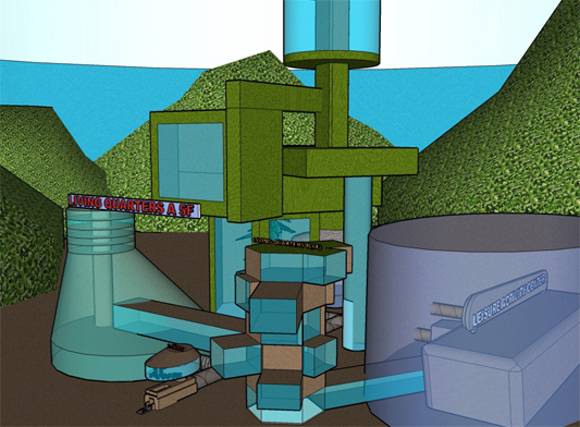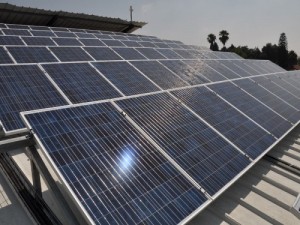 Dan Bloom, an advocate of polar cities (a prototype for a building above), paints a bleak future for the Middle East. Action against climate change is needed now.
Dan Bloom, an advocate of polar cities (a prototype for a building above), paints a bleak future for the Middle East. Action against climate change is needed now.
Two recent international news stories about climate change (“How much more proof is needed for people to act?” and “Ignoring the future — the psychology of denial,) emphasized the importance of facing major issues that will have an impact on the future of the human species.
Climate change is indeed an issue that is on everyone’s mind, and while most people in Israel and other parts of the Middle East seem to be far removed from the experts who recently made their way to Copenhagen to try — in vain, as it turns out — to hammer out blueprints to prevent global warming from having a Doomsday impact on humankind, the Middle East will also be on the front lines of these issues.
Despite most observers’ belief that solutions lie in mitigation, there are a growing number of climatologists and scientists who believe that the A-word — adaptation — must be confronted head-on, too. The fact is — despite the head-in-the-sand protestations of denialists like Marc Morano and Sarah Palin in the USA — that we cannot stop climate change or global warming.
The Earth’s atmosphere has already passed the tipping point, and in the next 500 years, temperatures and sea levels will rise considerably and millions, even billions, of people from the tropical and temperate zones will be forced to migrate in search of food, fuel and shelter. This includes the people of all nations in the
Middle East.
By the year 2500, the Middle East region will be largely uninhabited, except for a few stragglers eking out subsistence lives in mountainous areas. The rest of the Middle East population will have migrated north
to Russia’s northern coast or northern parts of Alaska and Canada to find safe harbor from the devastating impact of global warming.
They will have left the region for faraway northern climes to find shelter in UN-funded climate refuges in places such as Russia, Canada and Alaska. Israeli, Palestinian, Egyptian and Iranian climate refugees will join millions of others from India, Vietnam, Thailand, Japan and the Philippines. It won’t be a pretty picture.
When this blogger asked acclaimed British scientist James Lovelock if such a scenario for the Middle East was likely, he said in an e-mail: “It may very well happen, yes.” (Lovelock’s book “Gaia” was featured here on Green Prophet – click this link to read it).
We humans cannot engineer our way out of global warming, although scientists who believe in geo-engineering have offered theories on how to do it (a tower that sucks up greenhouse gases?). There are no easy fixes. Humankind has pumped too many greenhouse gases into the atmosphere, the result of the industrial revolution that gave us trains, planes, automobiles and much more, enabling us to live comfortable and trendy lives — and now there is so much carbon dioxide in the atmosphere that the Earth cannot recover.
The people of the Middle East region, like the rest of the world, is doomed to a bleak future full of billions of climate refugees seeking shelter in the far north, and in places like New Zealand, Tasmania and Antarctica in the far south.
Meetings in Copenhagen and Rio de Janeiro and at the UN in Manhattan will not stop global warming.
What we need to focus on now is preparing future generations for what our world will become in the next 500 years and how best to survive it.
For the next 100 years or so, life will go on as normal in Israel and its neighboring countries. There is nothing to worry about now. For the next 100 years posh department stores will hawk their trendy items, computer firms will launch their latest gadgets and airline companies will continue to offer passengers quick passage here and there, to the Maldives and to Manhattan, for business and for pleasure.
But in the next 500 years, according to Lovelock and other scientists who are not afraid to think outside the box and push the envelope, things are going to get bad. Unspeakably bad.
Those of us who are alive today won’t suffer, and the next few generations will be fine, too. The big trouble will probably start around 2200 and last for some 300 years or so.
By 2500, all the nations of the Middle East will be history, as will the nations of Africa, Asia, North America and Europe.
We are entering uncharted waters, and as the waters rise and the temperatures go up, future generations will have some important choices to make: where to live, how to live, how to grow food, how to power their climate refugee settlements, how to plan and how to pray.
Danny Bloom is a climate activist and writer based in Taiwan.




Friday, December 25, 3009Imagining Israel in the year 2500, special to the Jewish Telegraphic Agency Imagining Israel in the year 2500By Dan Bloomspecial to the Jewish Telegraphic Agency (JTA)Two recent newspaper articles about climate change in the far distant future, say 2500 or so, (titled, respectively, “How much more proof is needed for people to act?” and “Ignoring the future — the psychology of denial”) emphasized the importance of facing major issues that will have an impact on the future of the human species.Climate change is indeed an issue that is on everyone’s mind, and while Israel seems to be far removed from the experts who recently made their way to Copenhagen to try to hammer out blueprints to prevent global warming from having a Doomsday impact on humankind, Israel will also be on the front lines of these issues. Why? Because Israel will not exist as a country by the year 2500. Everyone there will have migrated north to Russia and Alaska.Despite most observers’ belief that solutions lie in mitigation, there are a growing number of climatologists and scientists who believe that the A-word — adaptation — must be confronted head-on, too. The fact is — despite the head-in-the-sand protestations of denialists like former Alaskan Governor Sarah Palin in the US — that we cannot stop climate change or global warming. The Earth’s atmosphere has already passed the tipping point, and in the next 500 years, temperatures and sea levels will rise considerably and millions, even billions, of people from the tropical and temperate zones will be forced to migrate in search of food, fuel and shelter. This includes the people of Israel.By the year 2500, Israel will be largely uninhabited, except for a few stragglers eking out a subsistence life in the Golan Heights. The rest of the population will have migrated north to Russia’s northern coast or northern parts of Alaska and Canada to find safe harbor from the devastating impact of global warming. MORE AT LINK:http://northwardho.blogspot.com/2009/12/imagini…
Friday, December 25, 3009Imagining Israel in the year 2500, special to the Jewish Telegraphic Agency Imagining Israel in the year 2500By Dan Bloomspecial to the Jewish Telegraphic Agency (JTA)Two recent newspaper articles about climate change in the far distant future, say 2500 or so, (titled, respectively, “How much more proof is needed for people to act?” and “Ignoring the future — the psychology of denial”) emphasized the importance of facing major issues that will have an impact on the future of the human species.Climate change is indeed an issue that is on everyone’s mind, and while Israel seems to be far removed from the experts who recently made their way to Copenhagen to try to hammer out blueprints to prevent global warming from having a Doomsday impact on humankind, Israel will also be on the front lines of these issues. Why? Because Israel will not exist as a country by the year 2500. Everyone there will have migrated north to Russia and Alaska.Despite most observers’ belief that solutions lie in mitigation, there are a growing number of climatologists and scientists who believe that the A-word — adaptation — must be confronted head-on, too. The fact is — despite the head-in-the-sand protestations of denialists like former Alaskan Governor Sarah Palin in the US — that we cannot stop climate change or global warming. The Earth’s atmosphere has already passed the tipping point, and in the next 500 years, temperatures and sea levels will rise considerably and millions, even billions, of people from the tropical and temperate zones will be forced to migrate in search of food, fuel and shelter. This includes the people of Israel.By the year 2500, Israel will be largely uninhabited, except for a few stragglers eking out a subsistence life in the Golan Heights. The rest of the population will have migrated north to Russia’s northern coast or northern parts of Alaska and Canada to find safe harbor from the devastating impact of global warming. MORE AT LINK:http://northwardho.blogspot.com/2009/12/imagini…